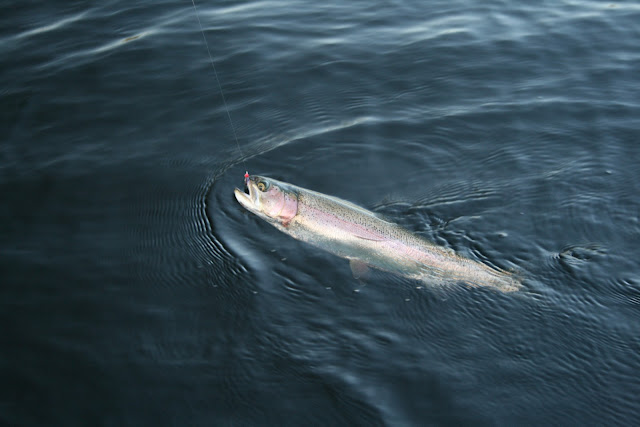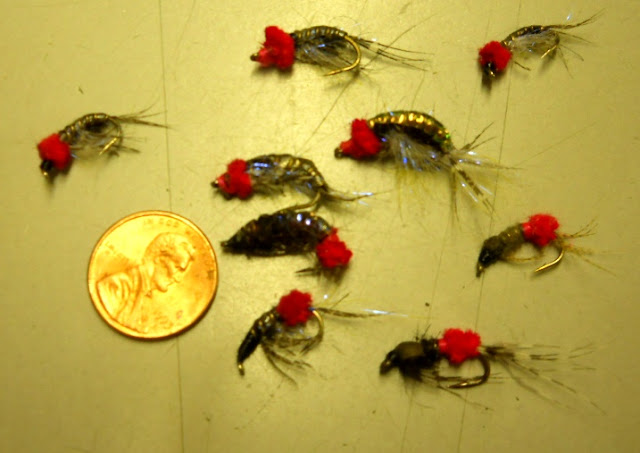The weatherman promised three days of balmy, sunny weather before the first big storm that would start winter in interior Alaska, with that in mind, we launched the boat on a partly cloudy day with the sun trying to shine through in places.
Bessie my seven month old Chessie/Lab mix learning about boats.
The Chatanika in fall colors. The weather started out pretty good on the first day but deteriorated fast, we didn't get the weather we were promised. It got cold and windy and we had to fight a two day head wind, fortunately we had a small outboard to help with it.
Bessie styling in her new Browning float coat.
The haul-out at Murphy Dome road. I wasn't able to add any new species to my tally, the water was high and murky, a condition that makes it hard to locate and fish white fish. I did catch some grayling on Moths and Egg Butt Scuds. I shot some ducks for Bessie to work on, at first the cold, turbulent water startled her, but she did very well on her water retrieves after she got used to it. We didn't see a moose to shoot, and we were not unhappy about it. The journey was kind of arduous as it was without adding a moose to the mix. I will have to wait for next year to try again for white fish, and probably do the float in four days instead of three.
The Kenai for rainbows
On October 18th I was headed down to Kenai to an NRA banquet where I was donating two of my 1911 knives (I am a custom knife maker) for their fundraiser. I was thinking it would have been a shame to make a trip down to the Kenai without spending at least a little bit of time with my butt in a boat. It was very near the end of the fish guiding season, but we were able to find a guide with an opening on Saturday morning.
We met our guide Jason Westmiester (that's his drift boat to the left) at the lower Skilak landing to drift the middle section of the Kenai for rainbows and char. The temperature was right at freezing, but it was supposed to be a sunny day. Come on sun.
Ever-present eagles. We drifted with bead-egg imitations under strike indicators and got bites from time to time. We caught some small char, but the rainbows were cagey. Finally Mike hooked into something that looked really good.
Jason and Mike with his 28 1/2 inch steelhead, a very nice fish for our guides second to last fishing day on the Kenai this fall, and Mikes first steelhead.
Jason releasing the nice steely. It was the only one we caught, but it made the trip worth it.
Spawned-out salmon in the headwaters of the Kenai waiting to die and add nutrients back to the land and water.

Flesh from spawned-out salmon in the upper river. Flesh flies are effective for trout and char in the mid to late season. It's important to know what it looks like in order to be able to tie good imitations.
Some very large brown bear tracks along the creek where fish are dieing. As I am writing this in mid November, we are hearing news of two trappers on the Kenai that were just mauled by a brown bear while setting for coyotes. Bears are late getting into the den when food is plentiful.

The sun sets on another beautiful day on the Kenai, our last one for the season. I can't wait to get back. Over the winter I will work on some soft, weighted egg imitations. My idea is to make egg imitations that drift naturally and remove the strike indicator and the split shots from the set-up so that my line will go straight from my rod tip to the fly. Hopefully, I'll be able to sense a strike and react before the fish realizes he has a fake in his mouth. I'll show some of what I'm developing in a future post. I will also work on some flesh fly and flesh fly/egg pattern combinations.
Stay tuned for fly tying through the winter. I will be testing some patterns through the ice this winter, but will not add any fish caught to my tally because I will not be able to use traditional fly fishing methods.
Thanks for looking. Mark




































































